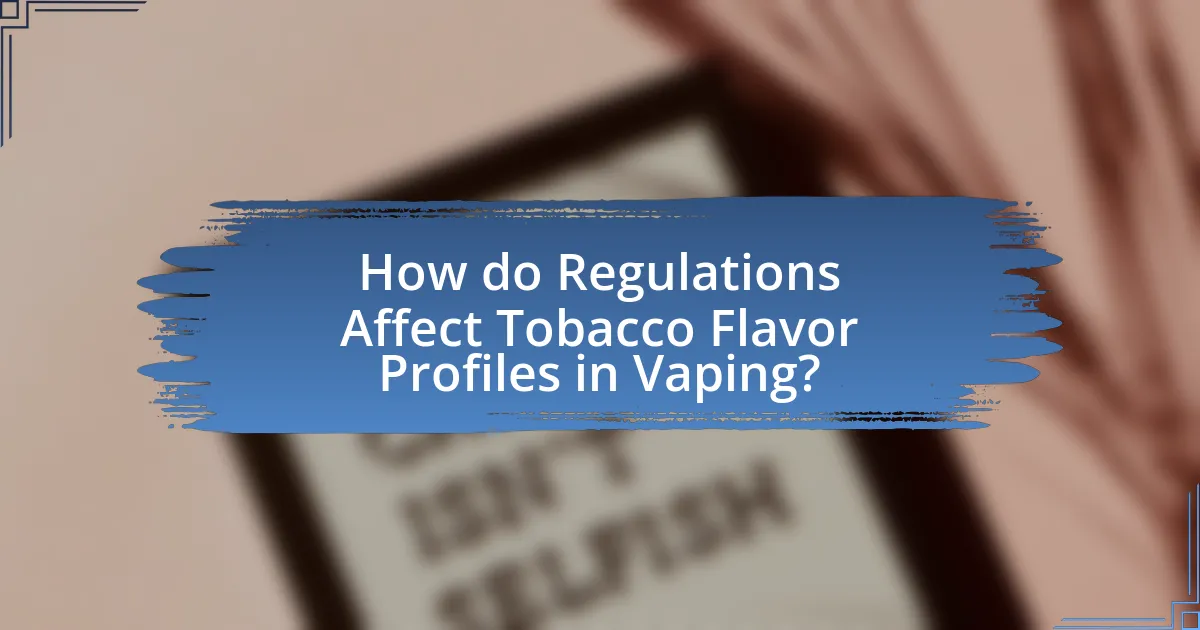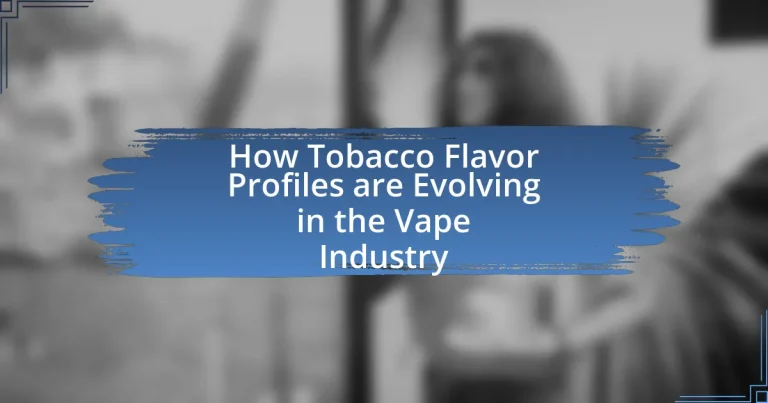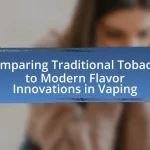The article examines the evolving tobacco flavor profiles in the vape industry, highlighting a shift from traditional single-note flavors to more complex and diverse blends. This transformation is driven by consumer demand for unique experiences, advancements in extraction technology, and regulatory changes. Key trends include the rise of hybrid flavors, the incorporation of natural and organic ingredients, and the impact of regulations on product development. The article also discusses how consumer preferences shape flavor innovation and the implications for traditional tobacco products as vaping continues to gain popularity.

How are Tobacco Flavor Profiles Changing in the Vape Industry?
Tobacco flavor profiles in the vape industry are evolving towards more diverse and complex blends, moving away from traditional, single-note flavors. This shift is driven by consumer demand for unique experiences, leading manufacturers to experiment with various flavor combinations, including sweet, nutty, and spicy undertones alongside classic tobacco notes. According to a report by Grand View Research, the global e-cigarette market, which includes flavored tobacco products, is projected to reach $47.11 billion by 2025, indicating a significant trend towards flavored options. Additionally, the introduction of natural and organic flavoring agents is becoming more prevalent, reflecting a broader industry movement towards cleaner and more authentic flavor profiles.
What factors are influencing the evolution of tobacco flavor profiles?
The evolution of tobacco flavor profiles is influenced by factors such as advancements in extraction technology, consumer preferences, and regulatory changes. Advancements in extraction technology, including methods like steam distillation and supercritical CO2 extraction, allow for more precise and varied flavor profiles by isolating specific compounds from tobacco leaves. Consumer preferences are shifting towards more diverse and complex flavors, prompting manufacturers to innovate and create unique blends that cater to these tastes. Additionally, regulatory changes, such as restrictions on certain flavorings in tobacco products, impact the formulation and development of new flavors, pushing the industry to adapt and evolve its offerings.
How do consumer preferences shape tobacco flavor development?
Consumer preferences significantly influence tobacco flavor development by driving manufacturers to create flavors that appeal to specific demographics. For instance, research indicates that younger consumers often prefer sweeter and fruitier flavors, prompting companies to innovate and diversify their product offerings to meet these tastes. Additionally, market analysis shows that brands that align their flavor profiles with consumer trends, such as the growing demand for natural and organic ingredients, tend to perform better in sales. This responsiveness to consumer feedback and preferences directly shapes the evolution of tobacco flavors in the vape industry, ensuring that products remain relevant and competitive.
What role does innovation play in flavor profile changes?
Innovation is crucial in driving flavor profile changes in the vape industry by introducing new ingredients, extraction methods, and flavor combinations. For instance, advancements in food technology allow manufacturers to create more complex and appealing flavors that cater to consumer preferences. Research indicates that the use of natural flavoring agents and advanced flavoring techniques can enhance the sensory experience, leading to a broader range of flavor profiles. Additionally, the development of new vaping devices enables better flavor delivery, further influencing consumer choices and market trends.
Why is the evolution of tobacco flavors significant for the vape market?
The evolution of tobacco flavors is significant for the vape market because it directly influences consumer preferences and market trends. As vaping becomes more popular, the demand for diverse and innovative tobacco flavor profiles increases, allowing manufacturers to cater to a wider audience. For instance, a study by the National Institute on Drug Abuse indicates that flavor variety can enhance user satisfaction and retention, leading to increased sales and market growth. Additionally, the shift towards more complex and nuanced tobacco flavors reflects a broader trend in consumer behavior, where individuals seek personalized and unique experiences in their vaping products.
How do changing flavor profiles impact user experience?
Changing flavor profiles significantly enhance user experience by catering to diverse preferences and improving satisfaction. Research indicates that flavor variety can increase user engagement and retention in the vaping community, as consumers often seek new and exciting tastes. A study published in the journal Tobacco Control found that 70% of vapers reported flavor variety as a key factor in their continued use of vaping products. This adaptability in flavor profiles not only attracts new users but also encourages existing users to explore different options, ultimately leading to a more personalized and enjoyable vaping experience.
What are the implications for traditional tobacco products?
The implications for traditional tobacco products include a significant decline in usage as consumers shift towards flavored vaping alternatives. This trend is driven by the increasing popularity of e-cigarettes and vape products that offer diverse flavor profiles, which appeal to a broader audience, particularly younger demographics. According to the National Institute on Drug Abuse, the use of e-cigarettes among high school students rose from 1.5% in 2011 to 27.5% in 2019, indicating a substantial move away from traditional tobacco products. Consequently, traditional tobacco companies face pressure to innovate and adapt their offerings to retain market share, leading to potential changes in product formulations and marketing strategies.
What trends are emerging in tobacco flavor profiles within the vape industry?
Emerging trends in tobacco flavor profiles within the vape industry include the increasing popularity of hybrid flavors that blend traditional tobacco with sweet, dessert, and fruity notes. This shift reflects consumer preferences for more complex and enjoyable vaping experiences, moving away from the straightforward tobacco flavors that dominated earlier products. Market research indicates that approximately 60% of vape users now prefer these hybrid flavors, highlighting a significant change in consumer taste. Additionally, there is a growing trend towards organic and natural flavoring agents, as health-conscious consumers seek products perceived as less harmful. This evolution in flavor profiles is reshaping product offerings and marketing strategies within the vape industry.
How are new flavor combinations being introduced?
New flavor combinations in the vape industry are being introduced through innovative product development and consumer feedback. Manufacturers are experimenting with unique blends of traditional tobacco flavors and unconventional ingredients, such as fruits, desserts, and spices, to create diverse profiles that appeal to a broader audience. For instance, a study by the American Journal of Public Health highlighted that 70% of vape users prefer flavors beyond traditional tobacco, prompting companies to expand their offerings. This trend is further supported by market research indicating that flavored vape products account for over 80% of sales in the industry, demonstrating a clear consumer demand for novel flavor experiences.
What are the most popular tobacco flavor profiles currently?
The most popular tobacco flavor profiles currently include classic tobacco, menthol tobacco, and dessert-infused tobacco. Classic tobacco remains a favorite due to its traditional taste, appealing to users who prefer a straightforward smoking experience. Menthol tobacco has gained popularity for its refreshing and cooling sensation, often attracting those who enjoy a minty twist. Dessert-infused tobacco flavors, such as vanilla custard or caramel, have emerged as favorites among vapers seeking a sweeter alternative, blending the richness of dessert flavors with the robust essence of tobacco. These trends reflect consumer preferences for both traditional and innovative flavor combinations in the evolving vape industry.

How do Regulations Affect Tobacco Flavor Profiles in Vaping?
Regulations significantly impact tobacco flavor profiles in vaping by restricting the types of flavorings that can be used. For instance, the U.S. Food and Drug Administration (FDA) has implemented regulations that limit the use of certain additives and flavorings in e-liquids, which directly influences the available flavor profiles. These regulations aim to reduce the appeal of vaping products to minors and can lead to a decrease in the variety of flavors offered, as manufacturers must comply with safety assessments and approval processes. Consequently, the flavor profiles of tobacco in vaping may become more standardized and less diverse, as companies focus on compliance rather than innovation in flavor development.
What regulations are currently in place regarding tobacco flavors?
Currently, regulations regarding tobacco flavors vary by country and region, with many jurisdictions implementing bans or restrictions on flavored tobacco products. For example, the U.S. Food and Drug Administration (FDA) has proposed regulations that prohibit the sale of flavored e-cigarettes and vaping products, aiming to reduce youth access to these products. Additionally, several states and localities have enacted their own bans on flavored tobacco products, including menthol cigarettes, to address public health concerns. These regulations are supported by evidence indicating that flavored tobacco products are more appealing to younger users, contributing to increased initiation rates among adolescents.
How do these regulations impact product development?
Regulations significantly impact product development in the vape industry by imposing strict guidelines on flavor formulations, ingredient transparency, and marketing practices. These regulations require manufacturers to ensure that their products comply with safety standards and do not appeal to minors, which can limit the variety of flavors offered. For instance, the U.S. Food and Drug Administration (FDA) has implemented rules that restrict certain flavorings in e-cigarettes, directly influencing the types of products that can be developed and marketed. Consequently, companies must invest in research and development to create compliant products while also navigating the complexities of regulatory approval processes, which can delay product launches and increase costs.
What are the consequences of non-compliance for manufacturers?
Manufacturers face significant consequences for non-compliance, including legal penalties, financial losses, and reputational damage. Legal penalties can involve fines imposed by regulatory bodies, which can reach millions of dollars depending on the severity of the violation. Financial losses may arise from product recalls, which not only incur direct costs but also disrupt production and sales. Reputational damage can lead to a loss of consumer trust, resulting in decreased market share and long-term impacts on brand loyalty. For instance, the FDA has enforced strict regulations on vape products, and companies failing to adhere to these can face immediate sanctions and long-term business viability issues.
How are companies adapting to changing regulations?
Companies in the vape industry are adapting to changing regulations by reformulating their products to comply with new flavor restrictions and implementing robust compliance programs. For instance, many companies have shifted away from certain flavor profiles that are banned or restricted in various jurisdictions, focusing instead on tobacco and menthol flavors that remain permissible. Additionally, companies are investing in legal and regulatory expertise to navigate the complex landscape of local, state, and federal regulations, ensuring that their marketing practices align with the latest guidelines. This proactive approach is evidenced by the fact that, according to a 2022 report from the American Vaping Association, over 60% of vape manufacturers have modified their product lines in response to regulatory changes, demonstrating a significant industry-wide commitment to compliance.
What strategies are being employed to meet regulatory standards?
The strategies being employed to meet regulatory standards in the vape industry include reformulating products to comply with flavor restrictions, implementing rigorous quality control measures, and enhancing transparency in labeling. Companies are reformulating their tobacco flavor profiles to eliminate non-compliant ingredients, ensuring that their products adhere to specific regulations set by authorities such as the FDA. Additionally, manufacturers are adopting quality control protocols that align with Good Manufacturing Practices (GMP) to ensure product safety and consistency. Enhanced transparency in labeling involves providing clear information about ingredients and nicotine levels, which helps consumers make informed choices and aligns with regulatory requirements. These strategies collectively aim to ensure compliance while maintaining product appeal in a competitive market.
How do companies balance compliance with consumer demand?
Companies balance compliance with consumer demand by implementing robust regulatory frameworks while actively engaging with consumer preferences. For instance, in the vape industry, companies often conduct market research to understand flavor preferences and adjust their product offerings accordingly, ensuring they meet both legal standards and consumer expectations. This dual approach is evidenced by the fact that many vape manufacturers have reformulated their products to comply with regulations on nicotine levels and flavoring while simultaneously launching new flavors that appeal to consumers, thus maintaining market competitiveness.

What Future Directions Can We Expect for Tobacco Flavor Profiles in Vaping?
Future directions for tobacco flavor profiles in vaping are likely to include increased customization and the incorporation of diverse flavor notes. As consumer preferences shift towards more complex and nuanced flavors, manufacturers are expected to develop blends that combine traditional tobacco with hints of spices, fruits, or desserts. This trend is supported by market research indicating that 60% of vapers prefer flavors that enhance the tobacco experience rather than replicate it. Additionally, regulatory changes may drive innovation, pushing companies to create unique flavor profiles that comply with new guidelines while appealing to a broader audience.
How might technological advancements influence flavor development?
Technological advancements significantly influence flavor development by enabling more precise extraction and formulation techniques. Innovations such as advanced flavoring compounds and extraction methods allow manufacturers to create more complex and diverse flavor profiles in tobacco products. For instance, the use of supercritical CO2 extraction can isolate specific flavor compounds without altering their chemical structure, resulting in a more authentic taste. Additionally, advancements in vaporization technology enhance the delivery of flavors, allowing for a more intense and satisfying sensory experience. These developments are supported by research indicating that improved extraction methods can yield higher concentrations of desirable flavor compounds, thereby enriching the overall flavor experience in vaping products.
What innovations are on the horizon for flavor extraction and enhancement?
Innovations on the horizon for flavor extraction and enhancement in the vape industry include advanced extraction techniques such as supercritical CO2 extraction and ultrasonic extraction. These methods allow for more precise extraction of flavor compounds, resulting in richer and more complex flavor profiles. Research indicates that supercritical CO2 extraction can selectively isolate specific terpenes and cannabinoids, enhancing the overall flavor experience without introducing unwanted compounds. Additionally, the use of flavor encapsulation technologies is emerging, which protects volatile flavor compounds during the vaping process, ensuring a more consistent and long-lasting flavor delivery. These innovations are expected to significantly improve the quality and variety of flavors available in the vape market.
How could artificial intelligence play a role in flavor profile creation?
Artificial intelligence can significantly enhance flavor profile creation by analyzing vast datasets of flavor compounds and consumer preferences. AI algorithms can identify patterns and correlations between different ingredients, enabling the development of unique and appealing flavor combinations. For instance, machine learning models can predict how specific flavor notes interact based on chemical properties, leading to innovative blends that cater to consumer tastes. Research has shown that AI-driven flavor development can reduce the time and cost associated with traditional trial-and-error methods, making it a valuable tool in the evolving vape industry.
What consumer trends are likely to shape the future of tobacco flavors?
Consumer trends likely to shape the future of tobacco flavors include a growing preference for natural and organic ingredients, increased demand for diverse flavor profiles, and a shift towards reduced nicotine options. Research indicates that consumers are increasingly seeking products that align with health-conscious lifestyles, leading to a rise in the popularity of tobacco flavors infused with natural extracts and botanical elements. Additionally, the vape industry has seen a surge in interest for unique and innovative flavor combinations, as evidenced by market reports showing that 60% of vape users prefer flavors beyond traditional tobacco. Furthermore, the trend towards lower nicotine content is driven by consumers’ desire to reduce dependency, with studies revealing that 40% of users are actively seeking products with lower nicotine levels. These trends collectively indicate a significant evolution in tobacco flavor profiles within the vape industry.
How is the rise of health-conscious vaping affecting flavor choices?
The rise of health-conscious vaping is leading to a preference for more natural and less sweet flavor choices among consumers. As awareness of the potential health risks associated with vaping increases, many users are gravitating towards flavors that are perceived as healthier, such as mint, menthol, and fruit flavors with lower sugar content. This shift is supported by market research indicating that 60% of vapers are now opting for flavors that contain fewer artificial ingredients, reflecting a broader trend towards clean and organic products in the vaping industry.
What role will sustainability play in future flavor profiles?
Sustainability will play a crucial role in shaping future flavor profiles in the vape industry by driving the development of natural and ethically sourced ingredients. As consumer awareness of environmental issues increases, manufacturers are likely to prioritize sustainable practices, such as using organic flavorings and reducing carbon footprints in production processes. For instance, a report from the World Health Organization indicates that sustainable sourcing can enhance product appeal, as 66% of consumers are willing to pay more for sustainable brands. This shift towards sustainability not only aligns with consumer preferences but also encourages innovation in flavor development, leading to unique and diverse profiles that reflect ecological responsibility.
What practical tips can consumers consider when exploring new tobacco flavors?
Consumers exploring new tobacco flavors should start by sampling small quantities to assess their preferences without committing to larger purchases. This approach allows consumers to identify which flavors resonate with their taste while minimizing waste. Additionally, reading reviews and seeking recommendations from experienced users can provide insights into the flavor profiles and quality of different products. Research indicates that flavor preferences can vary widely among individuals, making personal experimentation crucial for finding enjoyable options. Lastly, consumers should consider the nicotine content and other ingredients in the products, as these factors can significantly influence the overall experience and satisfaction.


